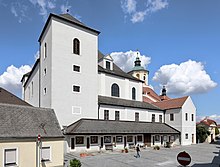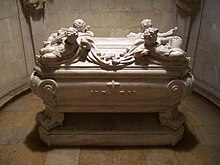Bergkirche (Eisenstadt)

The Roman Catholic Bergkirche Eisenstadt (also known as Haydn Church or Kalvarienbergkirche ) is located in the Oberberg-Eisenstadt district of the Eisenstadt municipality in Burgenland . It is the feast of the Visitation consecrated and belongs to the deanery Eisenstadt in Eisenstadt diocese . The building is a listed building .
The church is known for the neighboring " Kalvarienberg ", a place of pilgrimage, which has its model in the Kalvarienberg Maria Lanzendorf . The mountain church is also called " Haydn Church" after Joseph Haydn (1732–1809). Not far from Esterházy Palace, Haydn worked for large parts of his life as a composer and conductor. The Haydn mausoleum has been located in the Bergkirche since 1932 and contains the coffin of the composer Joseph Haydn.
Location description
The mountain church is attached to the west of the Kalvarienberg . It is located on Wiener Straße leading to the west with access from Joseph-Haydn-Platz.
history
The church was planned by Paul Esterházy (1635–1713) as a huge pilgrimage church. The foundation stone was laid in 1715. Due to the lack of interest from the builders, construction was interrupted. Under Nikolaus I. Joseph Esterházy de Galantha , the construction was continued around 1765 and the inauguration ceremony took place in 1803. In 1880 a renovation took place and in 1953 the church roof was re-covered. Another renovation took place outside and inside in 1954.
architecture
- Church exterior
The church is a four-sided block with a hipped roof . A two-storey vestibule with the adjoining two tower stumps on a square floor plan is in front of the building on the west side. They are closed by tent roofs . The sacristy is attached to the church to the south . In front of the sacristy, there are low huts for sale of devotional objects . The north hall was built around 1795. This has a flat central projection above a segmental arched door. The coat of arms of the Esterházy family is depicted in the risalits.
- Church interior
The church interior is circular with a western porch and shallow altar niches in the three other round sides. In between there are two high pilasters with beams on the sides of the doors and oratory windows. Lunette windows have been cut into the dome . Above the vestibule is the gallery, which rests on three groin vaults . A basket arch barrel vault is located above the organ .
The altarpiece “Maria Heimsuchung” is by Stephan Dorfmeister (1729–1797). The fresco in the dome by Wolfgang and Christian Köpp from 1772 shows "Ascension of Christ". It was renovated in 1889 by P. Müller and restored in 1954 again.
Haydn mausoleum
Joseph Haydn, who died in 1809, was exhumed in Vienna in 1820 and transferred to the Bergkirche in Eisenstadt. In 1932 Paul Esterházy had a mausoleum built under the north tower in the left wing of the mountain church, in which Haydn's remains were initially buried. However, the skull was in the possession of the Gesellschaft der Musikfreunde in Vienna and after a last-minute return of the skull failed, it was not until 1954 that the skull was ceremoniously united with the rest of the bones.
The mausoleum was built according to plans by the architect Franz Kraus. The allegorical depictions of the four seasons made of St. Margarethen sand-lime brick on the wall of the round dome room are an allusion to the oratorio by Joseph Haydn . The sculptor Oskar Thiede created the white marble sarcophagus .
organ
In 1797 Johann Gottfried Malleck (1733–1798), a Viennese organ builder , installed an organ according to the disposition given by Joseph Haydn ( Haydn organ ). It was rebuilt in 1950 by Rieger Orgelbau , restored in 1993 by the organ building workshop Karl Schuke and now has 34 stops on three manuals and pedal . The disposition is:
|
|
|
|
|||||||||||||||||||||||||||||||||||||||||||||||||||||||||||||||||||||||||||||||||||||||||||||||||||||||||||||||||||
- Coupling : II / I, III / I, III / II, I / P, II / P, III / P
literature
- Josef Rittsteuer , Johann Bauer: Kalvarienberg and Haydn Church in Eisenstadt. Propstei- and Stadtpfarre Eisenstadt-Oberberg, Eisenstadt 1995.
- Monika Soffner-Loibl: The mountain church in Eisenstadt-Oberberg - Haydn Church. Pilgrimage Church of the Visitation of the Virgin Mary. Patronage: July 2nd. Diocese of Eisenstadt - Federal State of Burgenland. Kunstverlag Peda , Passau 2009, ISBN 978-3-89643-747-1 ( Peda art guide 747).
Web links
Individual evidence
- ↑ Burgenland - immovable and archaeological monuments under monument protection. ( Memento from June 26, 2016 in the Internet Archive ) . Federal Monuments Office , as of June 21, 2016 (PDF).
- ^ A b Eisenstadt Tourismus (Magistrat Eisenstadt): Haydn-Mausoleum ; Retrieved Nov. 9, 2017
- ↑ Hannes Leopold: The 7 "Haydn Organs" in Eisenstadt and their dispositions. Haydn Festival Eisenstadt, 2010, accessed on April 14, 2018 . ; see. also the information at organindex.de
Coordinates: 47 ° 50 ′ 41.7 " N , 16 ° 30 ′ 42.4" E





